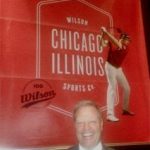You know what might be the nicest part of the Senior PGA Championship? It’s the one golf major played on any of the pro tours that seems to like coming to the Midwest. In fact, this Champions Tour shootout is the major played closest to Chicago in 2014. The closest the PGA Tour gets for a major is August’s PGA Championship at Valhalla in Louisville. The closest LPGA major is June’s U.S. Women’s Open at Pinehurst, in North Carolina.
This year’s 75th anniversary of the Senior PGA presented by KitchenAid is May 22-25 at Harbor Shores, in Benton Harbor, MI. – just a two-hour drive from Chicago and well worth the trip. I’ve been to the last two Senior PGAs and found them as captivating as any golf competitions – even without big-name players winning the title.
Harbor Shore also hosted in 2012 and Bellerive, the tradition-rich St. Louis club, was the venue last year.
Going forward, French Lick Resort will host the championship in 2015 and Harbor Shores has already committed for both 2016 and 2018. The 2017 site hasn’t been announced.
This tourney wasn’t always so Midwest-friendly. Sixty of the first 62 Senior PGAs were played in Florida. The first two championships, in 1937 and 1938, were played at Augusta National and the first champion was Jock Hutchison – the long-time Flossmoor Country Club pro. Those were the days when Augusta National was just getting started as the home of the Masters, an event first played in 1934.
Bringing the Senior PGA to Harbor Shores for the first time in 2012 represented a radical departure in tradition for the PGA of America. Harbor Shores’ Jack Nicklaus-designed course had been open for only 10 months before England’s Roger Chapman emerged as the surprise champion.
Now Harbor Shores is firmly in the tourney’s rotation. That shouldn’t be considered so surprising, according to championship director Jeff Hinz.
“Think about who designed the course,’’ said Hinz. This Nicklaus design has received rave reviews, though the No. 10 green – the biggest, most undulating putting surface the Golden Bear ever created – isn’t always spoken of in glowing terms.
“The first time people see it, you wonder `what’s it all about?’’’ said Hinz. “Now it’s my favorite hole on the golf course.’’
Harbor Shores’ course won’t look much different than it did two years ago. The most significant change came with the rebuilding of the No. 17 green, a move designed to tie the par-3 hole in more closely with a nature trail behind the putting surface.
The daunting par-4 seventh hole was altered, mainly to facilitate daily play. The third-hardest hole on the course in the 2012 Senior PGA featured a very large, deep bunker marked with dune grass. Now sod has replaced the dune grass. Otherwise there are no notable changes to the course.
With the rest of the facility, though, that’s another story. The grand opening of the Inn at Harbor Shores, a 92-room hotel on the St. Joseph River, will be celebrated during the tournament. It also has 14 luxury suites and its top two floors are condominiums. The rooftop is a meeting area.
Next to the Inn is a new 100-slip marina, which can accommodate boats up to 90 feet long. The hotel, marina and residential real estate comprise a $114 million parcel that will get full exposure for the first time during tournament week.
Then there’s the Renaissance Athletic Center, a 23,000-square foot state of the art fitness facility located near the second hole of the course with an additional outdoor field and swimming pool. There’s also a lot more real estate on the premises than there was in 2012. Two of the condominium developments were in the early stages of development two years ago. Now Hideaways is 65 percent filled and Fairways is at 30 percent. The new Trailside Cottages, opened for only one year, are half-sold.
Hinz views the setting as something special.
“It’s small town, middle America hosting a major golf championship,’’ he said. “The 156 players come from all over the world, and the people who came two years ago will be pleasantly surprised by the growth and development.’’
The competition will be as stiff as ever, with U.S. Ryder Cup captain Tom Watson in the field after missing last year’s event at Bellerive with a wrist injury. A two-time champion (2001, 2011) he was one of 28 winners of previous major championships invited to this Senior PGA, and about 20 are expected to compete at Harbor Shores. Colin Montgomerie, Miguel Angel Jimenez, Rocco Mediate and Jeff Maggert – established players before turning 50 within the last year – will be playing in the tournament for the first time and the popular Peter Jacobson will make his Harbor Shores debut after missing the 2012 tourney because of illness.
Defending champion in the 156-man starting field will be Kohki Idoki, who rarely plays outside of his native Japan. The Champions Tour mainstays trying to dethrone him include Fred Couples, Bernhard Langer, Curtis Strange, Mark O’Meara, Hal Sutton, Hale Irwin, Craig Stadler, Kenny Perry, Jay Haas and Fred Funk. Perry set the Harbor Shores record with a 62 in the final round two years ago, even though that sizzling score wasn’t enough to overhaul Chapman.
The tourney’s 1,870 volunteers are spread across 23 states, a testament to the tourney’s widespread popularity.
A variety of ticket options are available. Grounds-only tickets are $15 for the Tuesday and Wednesday practice rounds, $30 for the four tournaments rounds and $100 for all six days. Tickets allowing admission to the 19th hole amenities are $45 for the two practice days, $60 for the tournament rounds and $225 for the entire week. Complimentary off-site parking and shuttle service is included in the ticket prices.
Juniors 17 and under will be admitted free if accompanied by a ticket-buying adult. For ticket questions call (800) PGA-GOLF or check the tourney’s website at PGA.com.


